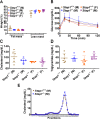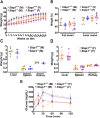Mice lacking global Stap1 expression do not manifest hypercholesterolemia
- PMID: 33228548
- PMCID: PMC7685646
- DOI: 10.1186/s12881-020-01176-x
Mice lacking global Stap1 expression do not manifest hypercholesterolemia
Abstract
Background: Autosomal dominant familial hypercholesterolemia (ADH; MIM#143890) is one of the most common monogenic disorders characterized by elevated circulatory LDL cholesterol. Initial studies in humans with ADH identified a potential relationship with variants of the gene encoding signal transducing adaptor family member protein 1 (STAP1; MIM#604298). However, subsequent studies have been contradictory. In this study, mice lacking global Stap1 expression (Stap1-/-) were characterized under standard chow and a 42% kcal western diet (WD).
Methods: Mice were studied for changes in different metabolic parameters before and after a 16-week WD regime. Growth curves, body fats, circulatory lipids, parameters of glucose homeostasis, and liver architecture were studied for comparisons.
Results: Surprisingly, Stap1-/- mice fed the 16-week WD demonstrated no marked differences in any of the metabolic parameters compared to Stap1+/+ mice. Furthermore, hepatic architecture and cholesterol content in FPLC-isolated lipoprotein fractions also remained comparable to wild-type mice.
Conclusion: These results strongly suggest that STAP1 does not alter lipid levels, that a western diet did not exacerbate a lipid disorder in Stap1 deficient mice and support the contention that it is not causative for hyperlipidemia in ADH patients. These results support other published studies also questioning the role of this locus in human hypercholesterolemia.
Keywords: Autosomal dominant familial hypercholesterolemia; B-cells; Familial hypercholesterolemia 4; Fast performance liquid chromatography; STAP1; Western diet.
Conflict of interest statement
The authors declare no competing interests.
Figures





Similar articles
-
Taking One Step Back in Familial Hypercholesterolemia: STAP1 Does Not Alter Plasma LDL (Low-Density Lipoprotein) Cholesterol in Mice and Humans.Arterioscler Thromb Vasc Biol. 2020 Apr;40(4):973-985. doi: 10.1161/ATVBAHA.119.313470. Epub 2020 Jan 30. Arterioscler Thromb Vasc Biol. 2020. PMID: 31996024 Free PMC article.
-
Mutations in STAP1 are associated with autosomal dominant hypercholesterolemia.Circ Res. 2014 Aug 29;115(6):552-5. doi: 10.1161/CIRCRESAHA.115.304660. Epub 2014 Jul 17. Circ Res. 2014. PMID: 25035151
-
Predicted pathogenic mutations in STAP1 are not associated with clinically defined familial hypercholesterolemia.Atherosclerosis. 2020 Jan;292:143-151. doi: 10.1016/j.atherosclerosis.2019.11.025. Epub 2019 Nov 29. Atherosclerosis. 2020. PMID: 31809983
-
Genes Potentially Associated with Familial Hypercholesterolemia.Biomolecules. 2019 Nov 29;9(12):807. doi: 10.3390/biom9120807. Biomolecules. 2019. PMID: 31795497 Free PMC article. Review.
-
[Congenital disorders of lipoprotein metabolism].Herz. 2017 Aug;42(5):449-458. doi: 10.1007/s00059-017-4578-x. Herz. 2017. PMID: 28555288 Review. German.
Cited by
-
Evaluation of a novel rapid genomic test including polygenic risk scores for the diagnosis and management of familial hypercholesterolaemia.Glob Cardiol Sci Pract. 2021 Dec 31;2021(4):e202131. doi: 10.21542/gcsp.2021.31. eCollection 2021 Dec 31. Glob Cardiol Sci Pract. 2021. PMID: 36185161 Free PMC article.
-
The Importance of Arterial Stiffness Assessment in Patients with Familial Hypercholesterolemia.J Clin Med. 2022 May 19;11(10):2872. doi: 10.3390/jcm11102872. J Clin Med. 2022. PMID: 35628997 Free PMC article. Review.
References
-
- Ezhov M, Bazhan S, Ershova A. Clinical guidelines for familial hypercholesterolemia. J Atherosclerosis Dyslipidemias. 2019;1:5–43.
-
- Goldberg AC, Hopkins PN, Toth PP, Ballantyne CM, Rader DJ, Robinson JG, Daniels SR, Gidding SS, de Ferranti SD, Ito MK, et al. Familial hypercholesterolemia: screening, diagnosis and management of pediatric and adult patients: clinical guidance from the National Lipid Association Expert Panel on familial hypercholesterolemia. J Clin Lipidol. 2011;5(3 Suppl):S1–S8. doi: 10.1016/j.jacl.2011.04.003. - DOI - PubMed
-
- Gidding SS, Champagne MA, de Ferranti SD, Defesche J, Ito MK, Knowles JW, McCrindle B, Raal F, Rader D, Santos RD, et al. The agenda for familial hypercholesterolemia: a scientific statement from the American Heart Association. Circulation. 2015;132(22):2167–2192. doi: 10.1161/CIR.0000000000000297. - DOI - PubMed
Publication types
MeSH terms
Substances
LinkOut - more resources
Full Text Sources
Medical
Molecular Biology Databases
Research Materials

